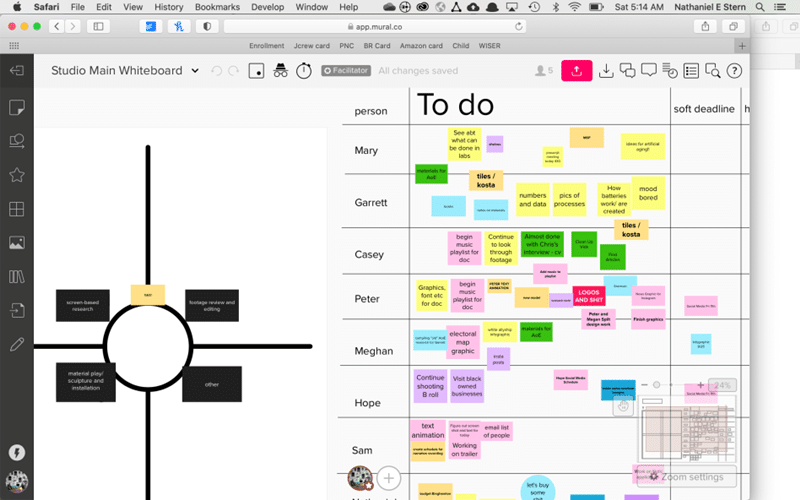
Keeping undergraduate students engaged and energized in ongoing research teams is an activity made more challenging by the need to meet exclusively online. Dr. Nathaniel Stern, a professor at the University of Wisconsin-Milwaukee with a dual appointment in Art and Mechanical Engineering, shared his experience working with online teams at a recent gathering of the Wisconsin Council on Undergraduate Research (WisCUR). Afterward, CURAH caught up with Dr. Stern to hear a bit more.
CURAH: What has the move to online teams taught you about what students need?
NS: In brief, there are four things my students need: empathy, energy, structure, and materiality. I provide these things through check-ins, “stokes,” schedules, and visual and material engagement.
I should say also that teams of students need these things regardless of present circumstances, but the need has certainly been amplified by having to meet online.
CURAH: Let’s take these one at a time: tell us about empathy.
NS: In terms of empathy, every meeting begins with a prompted sharing exercise: “The best part of my week was . . .” or “I feel up/down about X” or “I am looking forward to Y.” Sometimes I have them arrange what the empathy check-in will be. I participate, too, and we all respond to each other. In addition, I spend a little extra time with each student on rotation. Here, the goal is to make them feel heard and seen.
CURAH: Now, energy—and what are “stokes”?
NS: Stokes are little things we do to inject energy into our gatherings. We have silent dance parties, play Simon Says, throw invisible knives and balls to each other, set up poses and make drawings on our screens. The main goal here: we want to get out of our seats and get excited about what we are doing. Often, we tie this to where we are in the project, to aesthetics or brainstorming for new ideas, that sort of thing.
CURAH: How do you structure your online teams?
NS: We meet weekly, typically in groups of five. We maintain schedules and timelines, core to-do lists, and assignments using Gantt charts, Google sheets, MURAL with virtual sticky notes, and more. We work on these together, and my one or two most senior students take charge. They use these tools to create investment in the whole project, as well as accountability for individual tasks.
CURAH: Tell us what you mean by materiality.
NS: In my mind, it’s related to the stokes we do for energy. We want to remember we have bodies, that we are bodies, and that we make use of them. But this also means paying attention to visual materials and, well, things. We use MURAL for brainstorming frequently because it mimics a physical whiteboard and post-its. We send materials to each other to play with, we sketch and write during our time together as well as on our own, and we share out. In the fine arts, it should be said, we often confuse medium and discipline, so I make clear to my students that matter really does matter here!
One thing that also helps is that I actually make all of this transparent to my students. I let them in on what I am doing and why. I ask them for feedback on what they need. This mirrors how we make decisions about research direction together, and how we decide who works on what.
CURAH: Can you tell us about one of the projects you’re currently working on with student teams?
NS: I am working, in collaboration with artist and director (and UW-M alum) Samantha Tan, on a Zoom-bound documentary about the Black Lives Matter movement, entitled Leverage: Taking Antiracist Action in This Moment. With the coronavirus pandemic also in the background, the film presents how a variety of community members are working hard towards equity. We do not speak for the movement (or its leaders), but rather with diverse voices who are making Black lives matter. We share what they are both learning and doing, in order to ask us all to take action in this moment, and every moment.
CURAH: As we round into the second year of collaborative work constrained by the global pandemic, any last words?
We still do stokes at every meeting!
Written by: Editorial Team for CUR Arts and Humanities Division
For more information on Dr. Stern’s projects past and present, visit https://nathanielstern.com.
Please visit CURAH’s Blog to read the original article.
Founded in 1978, the Council on Undergraduate Research (CUR) focuses on providing high-quality and collaborative undergraduate research, scholarly, and creative activity. Among the many activities and networking opportunities that CUR provides, the organization also offers support for the professional growth of faculty and administrators through expert-designed institutes, conferences, and a wide-range of volunteer positions. The CUR community, made up of nearly 700 institutions and 13,000 individuals, continues to provide a platform for discussion and other resources related to mentoring, connecting, and creating relationships centered around undergraduate research. CUR’s advocacy efforts are also a large portion of its work as they strive to strengthen support for undergraduate research. Its continued growth in connections with representatives, private foundations, government agencies, and campuses world-wide provides value to its members and gives voice to undergraduate research. CUR is committed to inclusivity and diversity in all of its activities and our community.
CUR focuses on giving a voice to undergraduate research with learning through doing. It provides connections to a multitude of campuses and government agencies, all while promoting networking and professional growth to its community.


